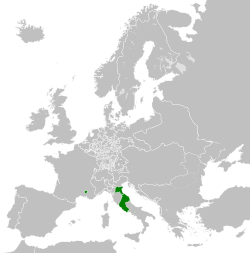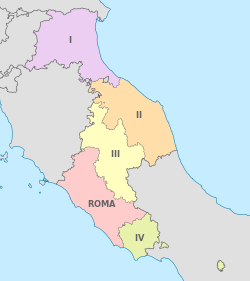
Back Kirchenstaat ALS Estaus Pontificios AN الدولة البابوية Arabic الدوله البابويه ARZ Estaos Pontificios AST Papa dövləti Azerbaijani پاپ دؤولتی AZB Папская вобласць Byelorussian Папская дзяржава BE-X-OLD Папска държава Bulgarian
State of the Church | |
|---|---|
| 756–1870 Interregna (1798–1799, 1809–1814 and 1849–1850) | |
Anthem:
| |
| Papal Shield | |
 Map of the Papal States (green) in 1789, including its exclaves of Benevento and Pontecorvo in southern Italy, and the Comtat Venaissin and Avignon in southern France | |
 | |
| Capital | Rome 41°54′00″N 12°29′15″E / 41.90000°N 12.48750°E |
| Common languages | |
| Religion | Roman Catholicism (state religion) |
| Government | (756–1798; 1800–1809)
|
| Pope | |
• 756–757 (first) | Stephen II |
• 1846–1870 (last) | Pius IX |
| Cardinal Secretary of State | |
• 1551–1555 (first) | Girolamo Dandini |
• 1848–1870 (last) | Giacomo Antonelli |
| Prime Minister | |
• 1847–1848 (first) | Gabriele Ferretti |
• 1848–1849 (last) | C. E. Muzzarelli |
| Legislature | Parliament (1848) |
| History | |
| 756 | |
| 781 | |
• Treaty of Venice (sovereignty reaffirmed) | 1177 |
• Publication of the Constitutiones Aegidianae | 1357 |
| February 1798 | |
| 17 May 1809 | |
| 20 September 1870 | |
• Annexation to the Kingdom of Italy | 09 October 1870 |
| 11 February 1929 | |
| Area | |
| Before 1859[5] | 44,000 km2 (17,000 sq mi) |
| Population | |
• 1853[6] | 3,124,668 |
| Currency |
|
| Today part of | |
 |
| This article is part of a series on |
| Vatican City |
|---|
The Papal States (/ˈpeɪpəl/ PAY-pəl; Italian: Stato Pontificio; Latin: Dicio Pontificia), officially the State of the Church (Italian: Stato della Chiesa [ˈstaːto della ˈkjɛːza]; Latin: Status Ecclesiasticus),[7] were a conglomeration of territories on the Italian Peninsula under the direct sovereign rule of the Pope from 756 to 1870.[8] They were among the major states of Italy from the 8th century until the Unification of Italy, which took place between 1859 and 1870, and culminated in their demise.
The state was legally established in the 8th century when Pepin the Short, king of the Franks, gifted Pope Stephen II, as a temporal sovereign, lands formerly held by Arian Lombards, adding them to lands and other real estate formerly acquired and held by the bishops of Rome, as landlords, from the time of Constantine onward. This donation came about as part of a process whereby the popes began to turn away from the Byzantine emperors as their foremost temporal guardians for reasons such as increased imperial taxes, disagreement with respect to iconoclasm, and failure of the emperors, or their exarchs in Italy, to protect Rome and the rest of the peninsula from barbarian invasion and pillage.[9]
During the Renaissance, the papal territory expanded greatly, and the Pope became one of Italy's most important rulers as well as the head of Western Christianity. At their zenith, the Papal States covered most of the modern Italian regions of Lazio (which includes Rome), Marche, Umbria, Romagna and portions of Emilia. The popes' reign over these lands was an exemplification of their temporal powers as secular rulers, as opposed to their ecclesiastical primacy.
By 1860, much of the Papal States' territory had been conquered by the Kingdom of Italy. Only Lazio, including Rome, remained under the Pope's temporal control. In 1870, the Pope lost Lazio and Rome and had no physical territory at all, except the Leonine City within Rome, which the new Italian state refrained from occupying militarily, despite its annexation. In 1929, the Italian fascist leader Benito Mussolini, the head of the Italian government, ended the "Prisoner in the Vatican" problem involving a unified Italy and the Holy See by negotiating the Lateran Treaty, signed by the two parties. This treaty recognized the sovereignty of the Holy See over a newly created territorial entity, a city-state within Rome limited to a token territory which became the Vatican City.
- ^ "Storia della Bandiera dello Stato della Città del Vaticano". vatican.va (in Italian). 31 December 2000.
Anticamente la bandiera dello Stato pontificio era giallorossa (o per meglio dire amaranto e rossa, colori derivati dai colori dello stemma della Santa Sede), i due colori tradizionali del Senato e del Popolo romano, che vennero tuttavia sostituiti con il bianco e il giallo nel 1808.
- ^ "Bandiera pontificia" (in Spanish). Estado de la Ciudad del Vaticano. Archived from the original on 31 July 2010. Retrieved 2024-03-09.
En el pasado, la bandera del Estado pontificio era de color amarillo y granate (o mejor dicho, carmesì y rojo, colores relacionados con el escudo de la Santa Sede), dos colores tradicionales del Senado y del Pueblo romano.
- ^ Vaticano, la bandiera di Porta Pia ritorna dopo 141 anni. www.lastampa.it. 2011. Retrieved 29 September 2011.
- ^ "Inno Pontificio e la sua storia" (in Italian). Statto della città del Vaticano. Archived from the original on 13 March 2010. Retrieved 26 August 2021.
- ^ Saylin, Gregory M. (November 1995). "The United Nations International Conference on Population and Development: Religion, Tradition, and Law in Latin America". Vanderbilt Journal of Transnational Law. 28 (5): 1263.
- ^ Statistica della popolazione dello Stato pontificio dell'anno 1853 (PDF). Ministero del commercio e lavori pubblici. 1857. p. xxii. Archived from the original (PDF) on 2 March 2018. Retrieved 1 March 2018.
- ^ Frederik de Wit, "Status Ecclesiasticus et Magnus Ducatus Thoscanae" (1700) Archived 2018-03-06 at the Wayback Machine
- ^ "Papal States". Encyclopædia Britannica. 30 April 2020. Archived from the original on 5 October 2021. Retrieved 11 August 2021.
- ^ "Papal States | historical region, Italy | Britannica". www.britannica.com. Archived from the original on 2021-11-15. Retrieved 2021-11-21.




